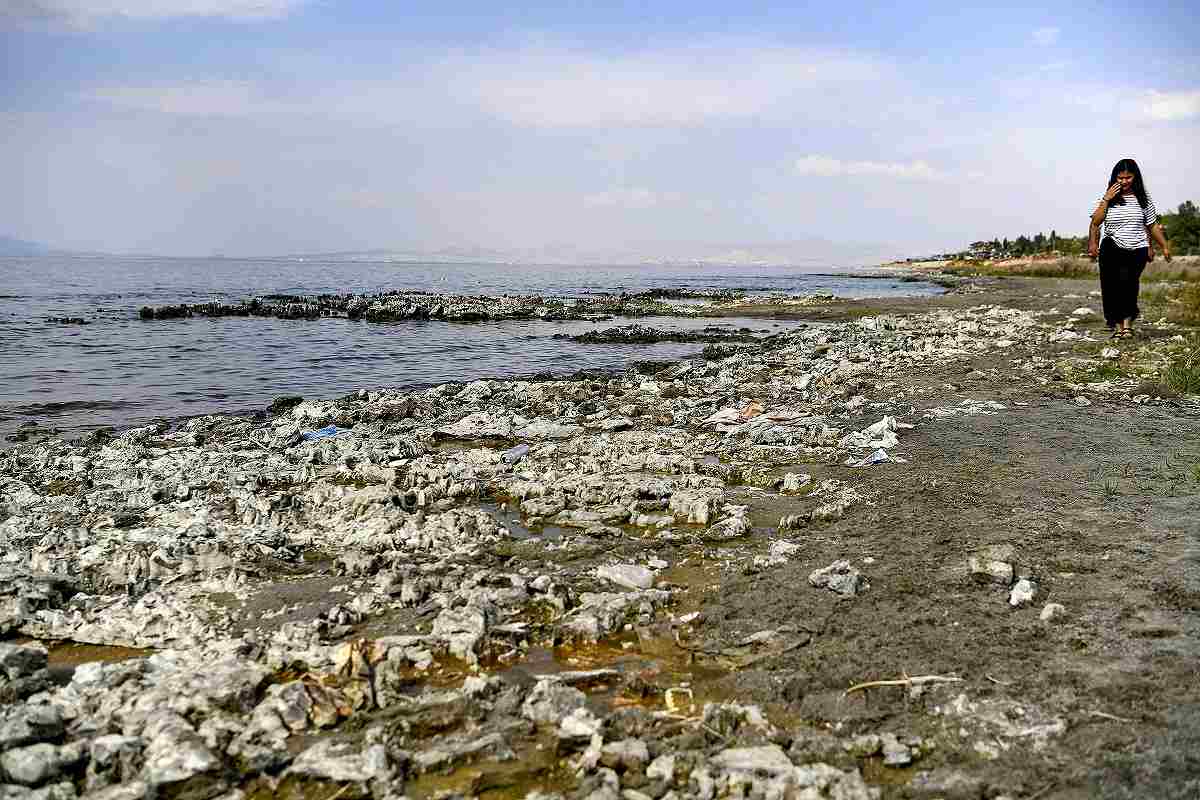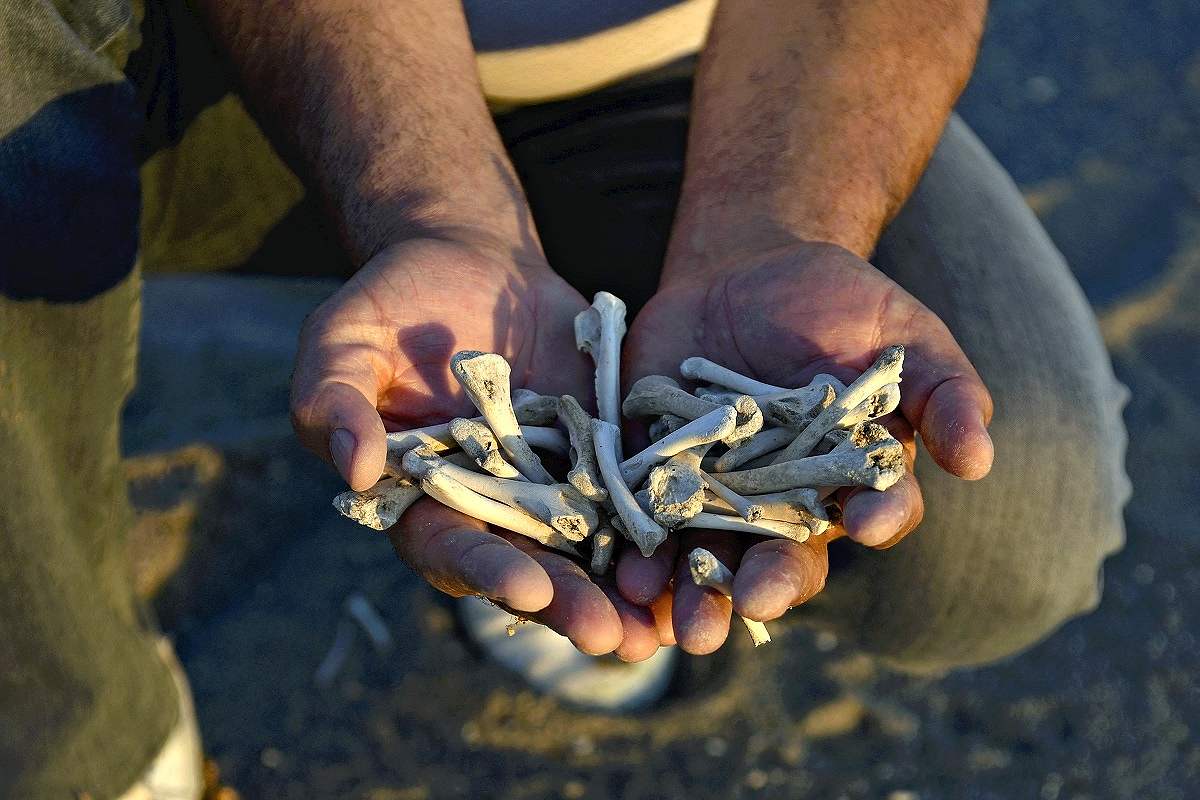
A woman walks next to ancient underwater rock-like structures, called microbialites, remaining on the surface as the waters of Lake Van have shrunk in recent years, in Van, Turkey, on Aug. 18.
13:52 JST, September 23, 2023
VAN, Turkey (AFP-Jiji) — Shepherd Ibrahim Koc recalls his youth with fondness as he grazes cattle on a barren field that was once lush with vegetation on the edge of Turkey’s largest lake.
An occasional shrub marks the spots from where Lake Van has retreated over years of global heating and drought.
“The animals are thirsty,” the 65-year-old lamented.
“There is no water,” Koc said, echoing sentiments expressed by a growing number of Turks who have watched their mountains lose ice caps and their water reservoirs dry up.
A weather map of Turkey — an agricultural superpower stretching from Bulgaria in the west to Iran in the east — shows much of the country suffering from a prolonged drought.
Shrinking shorelines are exposing lakebeds that pollute the air with a salty dust. Scientists fear the problems could grow only worse.
“I think these are our good days,” Faruk Alaeddinoglu, a professor at Van Yuzuncu Yil University, told AFP.
“We will witness the lake continuing to shrink in the coming years.”
Lake Van covers approximately 3,700 square kilometers, reaching a maximum depth of 450 meters.
Its surface area has shrunk by around 1.5% in recent years, according to measurements Alaeddinoglu carried out last autumn.
“That is a terribly large amount of water for a 3,700 square kilometer area,” he said.
‘Barren land’
In the Celebibagi neighborhood on the lake’s northern shore, the waters have receded by around four kilometers.
A long walk along the exposed lakebed is littered with bird bones, craggy bushes and dried dirt covered with sodium and other minerals.
“We are walking in an area which was once covered with the lake’s waters,” said Ali Kalcik, a local environmentalist.
“Now, it’s a barren land without a living thing.”
The sight of dazzling flamingos dancing in the air against the backdrop of mountains signals the spot where the lake finally begins.
Alaeddinoglu said the lake’s size had changed in the past because of rifts in tectonic plates that make Turkey into one of the most active earthquake zones in the world.
But he blamed the ongoing water loss on rising temperatures that result in “less precipitation and excessive evaporation.”
Almost three times as much of the lake’s water evaporates than comes back down in the form of rain, Alaeddinoglu said.
Lush gardens of newly-built summer cottages are also draining water from the region, where President Recep Tayyip Erdogan has built a government retreat.

Local environmentalist Ali Kalcik shows bones of birds that starved to death when pearl mullets that form their diet migrated early this year because of the drought.
‘Business is dying’
The problem has become so severe that officials are urging local farmers not to grow crops requiring too much water.
This means farmer Kinyas Gezer can no longer afford to grow sugar beets, which are a particularly thirsty vegetable.
“All my labor has been wasted,” the 56-year-old lamented, pointing to his shriveled apricots.
“If it goes on like this, we will abandon farming. The business is dying.”
The water loss also exposes pollution, according to Orhan Deniz, a professor of Yuzuncu Yil University, whose campus sits on the lake’s shore.
“Large patches of slime mixed with mud give off a bad smell and make human pollution more evident,” he said.
“In the 1990s, we would swim during lunch break and then go back to university,” he said, gazing at the lake from his office.
“Now it’s not possible to step in the water, let alone swim in it,” he said.
‘A bird massacre’
The lake is still popular with tourists and some locals swim along its more scenic parts.
Van Gov. Ozan Balci said his office has spent 80 million lira ($3 million) cleaning up the lake.
“We are doing our best to protect the lake because of its cultural heritage and people’s common memory,” he told AFP.
In the shoreline village of Adir, some locals swam and others picnicked under a tree.
But dead gulls lying not too far from the vacationers betrayed the ecological problems facing the lake.
Experts say pearl mullets that form the basis of the gulls’ diet migrated early this year because of the drought.
Deprived of food, the gulls simply starved to death.
“The remaining birds here have one more week. Then they will also die,” local villager Necmettin Nebioglu, 64, said.
“In the past, the seagulls would follow us while we were swimming. Now look, it’s a bird massacre,” he said, pointing to a pile of carcasses on the shore.
"Science & Nature" POPULAR ARTICLE
-

Genome Study Reveals Milestone in History of Cat Domestication
-

Big Leap in Quest to Get to Bottom of Climate Ice Mystery
-

Security Camera Footage Vulnerable to Outside Access; Investigation Finds 3,000 Pieces Exposed Online
-

Japan Set to Participate in EU’s R&D Framework, Aims to Boost Cooperation in Tech, Energy
-

Paws on Parade: Nairobi’s Dogs Dazzle at ‘Pawchella’
JN ACCESS RANKING
-

Tokyo Economic Security Forum to Hold Inaugural Meeting Amid Tense Global Environment
-

Keidanren Chairman Yoshinobu Tsutsui Visits Kashiwazaki-Kariwa Nuclear Power Plant; Inspects New Emergency Safety System
-

Imports of Rare Earths from China Facing Delays, May Be Caused by Deterioration of Japan-China Relations
-

University of Tokyo Professor Discusses Japanese Economic Security in Interview Ahead of Forum
-

Japan Pulls out of Vietnam Nuclear Project, Complicating Hanoi’s Power Plans























